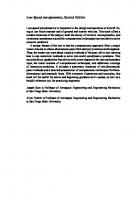
- Author / Uploaded
- Tom Lawson
Building Aerodynamics
BU/LD/NG AERODYWAM/CS ^ Torn Low$on ^ - ".-M^g 10 -H — — — — COUNTRY 100m INTO CITY 1000m INTO CITY CITY 1^ 50
3,502 2,060 13MB
Pages 304 Page size 409.44 x 610.08 pts Year 2010
Recommend Papers
File loading please wait...
Citation preview
BU/LD/NG AERODYWAM/CS ^
Torn Low$on
^
- ".-M^g
10
-H — — — —
COUNTRY 100m INTO CITY 1000m INTO CITY CITY
1^
50
/^^ ^
< ^ : 20
WIND SPEED in m/s
30
20
25
30
35
40
WIND SPEED in m/s
45
Building Aerodynamics Ch 1
23
FIG 1.09a NORMALISED SPECTRAL DENSITY FUNCTION FOR C O U N T R Y 0.25
0.25
vf 0.10
XT" \:'
^ '#
0.20
1§. 0-15
FIG 1.09b NORMALISED SPECTRAL DENSITY FUNCTION FOR CITY
/^
F^
0.001
^
0.01
0.10
:\
^
17^7
S . 0.15
S"-
HEIGHT = 100m ) HEIGHT = 30m HEIGHT = 5m
^ 0.05
0.20
0.1
FREQUENCY IN Hz
0.05
^rrr 10
- '-'-, ';,,
: ^S
-\1
/ \,r\,
T
1,,T,
-' ^\
HEIGHT = 100m HEIGHT = 30m HEIGHT = Sm
.,,,, ,r,u
r\ -. :^:::: i rrr ; : ' ; < ^ ;
0 0.001
0.01
0.1
10
FREQUENCY IN Hz
T h e change from country to city velocity profile is clearly shown on Figures 1.08; it is also clear from a comparison between Figures 1.08 a and b that the change in hourly-average wind speed is greater than for the 1-second average values. This is because the extra friction in the city both decreases the average wind speed and increases the turbulence. It should be noted that zero displacement height was specified for both country and city data, whereas in reality the displacement height (see Section 1.5.1) for the city would be about 20m. T h e spectra in Figures 1.09a and b show that there is not so m u c h difference between country and city as with height above ground If the location is exceptional, then a model should be m a d e of the site at a large enough scale so that it extends far enough to reach standard conditions at its edges, and this model should be tested to obtain site conditions. These conditions should then be modelled at an acceptable scale to allow both the atmosphere to be represented and the details of the model to be significant. Over the years the work of W i n d Engineers has spread to other fields, such as Environmental conditions around buildings, ventilation of buildings, the removal of smoke in the case of fire, and emissions from buildings. T h e study of emissions splits into near field and far field. T h e applicability of using high speed data is discussed in Section 1.5.3. 7.5.7. D M y / a c e m e n f 77e;g/!?









